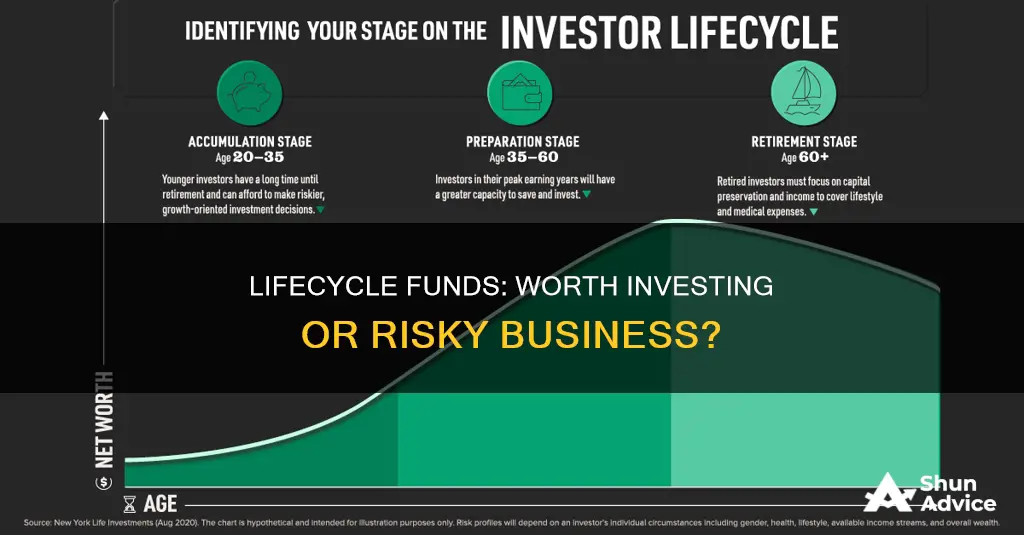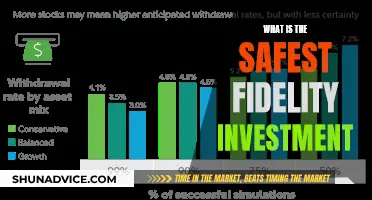
Lifecycle funds are a type of mutual fund that automatically adjusts its asset allocation to match an investor's risk tolerance as they near retirement. These funds are also known as age-based funds or target-date retirement funds. The main advantage of investing in a lifecycle fund is convenience, as it offers a set-and-forget retirement plan. However, critics argue that their age-based approach is flawed and that they may be too conservative for some retirees. Some also point out that lifecycle funds are usually more expensive than other investment options. Overall, while lifecycle funds can be a great option for some investors, they may not be suitable for those who want more control over their investments or have complex portfolios.
| Characteristics | Values |
|---|---|
| Type of fund | Diversified mutual fund, "fund of funds" |
| Risk | Reduced over time |
| Asset allocation | Automatically adjusted to maintain desired asset allocation over time |
| Investment goal | Investor picks a fund with a target date based on their investment goal |
| Management | Fund managers make decisions about asset allocation, diversification and rebalancing |
| Other names | Age-based funds, target-date retirement funds, target date funds |
| Advantages | Low-cost, low-maintenance, reasonably well-allocated among various asset classes, instant diversification, great for less sophisticated investors |
| Disadvantages | Not available in all accounts, misleading dates, lack of control, inappropriate for taxable accounts, usually more expensive |
What You'll Learn

What are the benefits of a lifecycle fund?
Lifecycle funds are a type of mutual fund that offers a range of benefits to investors, especially those planning for retirement. Here are some key advantages:
Convenience and Simplicity
Lifecycle funds offer a convenient, set-and-forget investment solution, making them ideal for investors seeking a passive approach to retirement planning. They simplify investment strategies by automatically adjusting the asset mix over time to match an investor's risk tolerance as they near their target retirement date. This adjustment is known as the "glide path."
Reduced Risk
As the target date approaches, lifecycle funds automatically shift towards a more conservative mix of investments, typically increasing the proportion of bonds and other fixed-income investments while reducing stocks. This helps to preserve capital and reduce the risk of sudden losses as retirement nears or during retirement.
Transparency and Predictability
Lifecycle funds provide transparency and predictability through their preset glide paths. Investors can easily understand how the fund's asset allocation will change over time, giving them greater confidence in the fund's strategy.
Instant Diversification
These funds provide instant diversification across various asset classes, helping to spread risk and maximize potential returns. They are well-allocated and diversified among asset classes, reducing the need for investors to actively manage their portfolios.
Low-Cost and Low-Maintenance
Lifecycle funds are often low-cost and low-maintenance investment options. They are widely available within 401(k) plans and are popular among investors, with 62% of 401(k) participants using them.
Suitability for Less Sophisticated Investors
They are ideal for less sophisticated investors who may not have the knowledge or time to actively manage their portfolios. They offer a one-stop mutual fund shopping solution, making them a great choice for investors with smaller portfolios or those with a single investing account, such as a Roth IRA.
Aquabounty's Mutual Fund Investors: Who's Taking the Plunge?
You may want to see also

What are the drawbacks of a lifecycle fund?
While lifecycle funds can be a great investment option, especially for investors with small portfolios located entirely within a single retirement account, they have some drawbacks. Here are some of the potential disadvantages of investing in a lifecycle fund:
- Limited availability: Lifecycle funds may not be available in all accounts, which defeats the purpose of having a one-stop mutual fund solution. If you have multiple accounts, such as 401(k)s, Roth IRAs, HSAs, and taxable accounts, you might need to mix lifecycle funds with other funds, making it more complex to manage your portfolio and calculate rebalancing.
- Misleading dates: The idea of choosing an asset allocation based solely on your planned retirement date may oversimplify things. It doesn't necessarily take into account your unique ability, need, and willingness to take on risk. Different fund companies offer varying asset allocations for any given date, so it's important to choose based on your desired asset allocation rather than just the date.
- Lack of control: Lifecycle funds automatically change your asset allocation over time, and some investors may prefer to have more control over this aspect of their investments. You might want to adjust your asset allocation based on market conditions or other factors rather than just your age or retirement date.
- Limited asset allocation: Lifecycle funds typically hold a limited number of asset classes, which may not align with your desired level of diversification. If you prefer to tilt your portfolio toward specific asset classes or include alternative investments, a lifecycle fund might not provide the flexibility you seek.
- Performance chasing: Like other fund managers, lifecycle fund managers may be prone to chasing performance, adding more aggressive asset allocations and glide paths to their funds. This can make these funds less stable than they market themselves to be. Additionally, fund companies may use lifecycle funds to promote their new mutual funds, which may not always be in the best interest of investors.
- Tax inefficiency: Lifecycle funds can be inappropriate for taxable accounts as they become increasingly tax-inefficient over time. As you get closer to retirement, the proportion of tax-inefficient asset classes, such as bonds, tends to increase. This can result in higher taxable capital gains within the fund, making it more challenging to optimise your portfolio's tax efficiency.
- Higher fees: Many lifecycle funds charge additional fees on top of the expense ratios of the underlying accounts. These higher fees can eat into your investment returns over time. It's important to carefully review the fee structure of any lifecycle fund before investing.
Mutual Funds in India: Worth the Investment?
You may want to see also

How do lifecycle funds work?
Lifecycle funds are designed for investors with specific goals that require capital at set times, and they are most commonly used for retirement investing. They are also known as "age-based funds" or "target-date retirement funds".
Lifecycle funds are a type of mutual fund that automatically adjusts its asset allocation to match an investor's risk tolerance as they get closer to their retirement date. This means that the fund will shift towards a more conservative mix of investments, generally becoming less aggressive as the years go by. For example, a lifecycle fund with a target retirement date of 2050 held in 2020 might initially hold 80% stocks and 20% bonds. Each year, the fund will gradually shift to include more bonds and fewer stocks, eventually reaching 40% stocks and 60% bonds by the target retirement date.
The main benefit of lifecycle funds is that they offer a convenient, passive approach to investing for retirement. They are also transparent about their "glide paths", or how the funds' allocations will change over time. However, critics argue that their age-based approach is flawed, as younger investors may not always be able to handle more risk. Additionally, lifecycle funds assume that they are an investor's only source of retirement income, which may not always be the case.
Overall, lifecycle funds can be a great option for investors with small portfolios located entirely within a single retirement account. However, they may not be suitable for those with more complex financial situations or those who prefer a more active approach to investing.
Invest 529 Funds: Strategies for Maximizing College Savings
You may want to see also

Are lifecycle funds a good option for retirement?
Lifecycle funds are a type of mutual fund designed for investors saving for retirement. They are also known as "age-based funds" or "target-date retirement funds". Lifecycle funds are designed to be used by investors with specific goals that require capital at set times. The main benefit of lifecycle funds is that they are convenient and can be put on autopilot, with the fund automatically adjusting its asset allocation to lower risk as the desired retirement date approaches. This is known as its "glide path".
For example, an investor who chooses a lifecycle fund with a target retirement date of 2050 might start with a fund that holds 80% stocks and 20% bonds. Each year, the fund will gradually shift towards more bonds and fewer stocks, eventually reaching 40% stocks and 60% bonds by the target retirement date. This helps to preserve capital and ensure that investors don't face sudden losses as they approach retirement.
However, there are also some criticisms and potential drawbacks of investing in lifecycle funds. One criticism is that the age-based approach may be flawed as it assumes that younger investors can handle more risk, which is not always the case. Additionally, lifecycle funds may have relatively high fees compared to simple index funds. They may also be inappropriate for taxable accounts as they become increasingly tax-inefficient over time.
Overall, lifecycle funds can be a good option for retirement, particularly for investors with small portfolios located entirely within a single retirement account. They offer a low-maintenance, well-allocated, and reasonably diversified investment solution. However, they may not be suitable for investors with more complex portfolios or those who prefer to have more control over their asset allocation.
The Best Places to Invest in Exchange-Traded Funds Directly
You may want to see also

How do I choose a lifecycle fund?
A lifecycle fund is a fund (commonly a mutual fund) that is automatically adjusted to match an investor's risk tolerance as they near retirement. This means that the percentage of bonds and other fixed-income investments increases as the desired retirement date approaches.
When choosing a lifecycle fund, it is important to consider the following:
- Target retirement date: The target retirement date of the fund should align with your own retirement plans. For example, if you plan to retire around 2030, you would choose a lifecycle fund with a target date around that year.
- Risk tolerance: Lifecycle funds are based on the idea that younger investors can handle more risk, but this is not always the case. It is important to consider your own risk tolerance when choosing a fund. Younger investors may want to opt for a fund with a higher percentage of stocks, while older investors may prefer a more conservative mix of investments with a higher percentage of bonds.
- Fees: Lifecycle funds typically have relatively high fees compared to simple index funds. Be sure to check the fees and weigh the cost against the benefits offered by the fund.
- Investment path: No two lifecycle funds follow the exact same path. It is important to review the prospectuses of any funds you are considering to ensure that the investment strategy aligns with your own retirement goals.
- Other sources of income: Lifecycle funds assume that this will be your only investment and source of retirement income. However, you may also have income from Social Security, a pension, or other investments. Therefore, it is important to consider lifecycle funds as just one part of your complete retirement plan.
A Beginner's Guide to Investing in Index Funds with E-Trade
You may want to see also
Frequently asked questions
A lifecycle fund is a fund (commonly a mutual fund) that is automatically adjusted during its life to match an investor's risk tolerance as he or she nears retirement.
Lifecycle funds offer the advantage of convenience. Investors can easily put their investing activities on autopilot with just one fund. Lifecycle funds are also a great one-stop mutual fund shopping solution that can be recommended to less sophisticated investors.
One factor that can limit returns for lifecycle funds is relatively high fees compared to simple index funds. Lifecycle funds also assume your only investment and your only source of retirement income is that one fund. They are also not available in all accounts.
A lifecycle fund investor picks a fund with the right target date based on their particular investment goal. For example, the L 2030 fund is designed for investors who plan to retire and start withdrawing their money around 2030.
Investors who want to take a more active approach can seek a financial advisor or use other types of funds to meet their investment goals.







